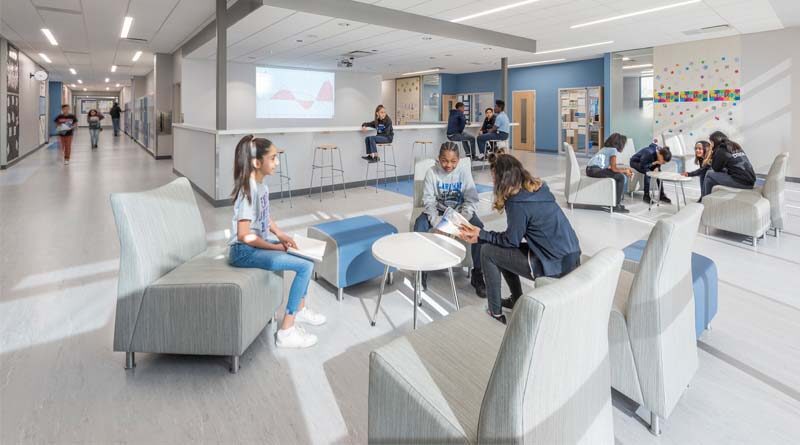New Illinois Grade School Receives Design Award
By SCN Staff
JOLIET, Ill.—Laraway School, a new $31 million PreK-8 school in Joliet, recently received the John N. Shaw Award for design and community planning. Sponsored by the Association for Learning Environments’ Midwest Great Lakes Chapter, the award recognizes top design that results from collaboration with educators, students, and community representatives.
Laraway School won the sole award in the competition—which encompasses 12 states and the province of Ontario, Canada. Key recipients include Laraway Community Consolidated School District 70C and Legat Architects, the architect of record.
Among the selection criteria for the award are how the design captures the educational vision, cost effectiveness, green features, and how it advances innovative learning environments.
The jury, consisting of planners and designers from throughout the nation, praised the project’s “great use of site and development of active outdoor learning spaces,” as well as a planning process that “was inclusive and really looked to maximize the cultural and community connection.”
Construction on Laraway School was completed in August 2018. Prior to this project, the school was undersized and inefficient and had changed little since it was built in the early 1950s. Additionally, nearly 98% of its students are low income. The Laraway Community Consolidated School District 70C community knew it was time for a change, so much so that a new school achieved an 80% “yes” ballot on the referendum ballot.
Today, students not only have an appropriately sized modern gym, but an entire new PreK-8 school that supports learning beyond the classroom, connects to the outdoors, encourages student and teacher collaboration, and even celebrates Joliet’s history.
The 119,000 square foot school, designed by Legat Architects, doubles the size of its predecessor and offers 460 students a spacious, light-filled setting featuring age-appropriate neighborhoods.
Henry Brothers was the construction manager on the project.
The layout of the school positions four grade-defined neighborhoods around a central courtyard. Each neighborhood features a “front porch” and active learning hub that responds to its students’ ages, while also encouraging staff collaboration. The spaces within the school accommodate different sizes: coaching rooms (2 to 3 students); small group learning areas (8 to 12 students); typical classrooms (20 to 28 students); active learning and flexible learning areas (40 to 50 students); and large assembly areas (50-plus students).
The school also features a 7th/8th grade modular tech lab that helps prepare students for Joliet Township High School’s Career Academies. Each two-week module within the lab connects with an academy at the high school.
The design of Laraway School also references Joliet’s physical and cultural heritage:
- A linear layout, east/west orientation, unique brick pattern, and floor/lighting patterns celebrate the city’s farming history.
- The main corridor, inspired by the nearby Wauponsee Glacial Trail, arcs through the facility.
- A “quarry wall” that connects the two entrances and curves through the cafeteria and courtyard gives a nod to Joliet’s legacy of quarrying limestone.
The design also employs several sustainable features:
- Roof and wall insulation exceed minimum R values for enhanced HVAC performance.
- All mechanical units have heat recovery to reduce the toll on the HVAC system.
- A daylight harvesting system includes east-west orientation, interior glass walls, and floor-to-ceiling exterior glass in each neighborhood.
- Pipes deliver stormwater to the outside, where it percolates into rain gardens.
The creation of the new Laraway School proves that districts serving disadvantaged families can unite communities to create cost-effective learning settings that emphasize student performance. The project also exemplifies school design that honors community context and history.
According to a statement from the John Shaw Award selection committee, “The Laraway School demonstrates great use of site and development of active outdoor learning spaces. The planning process was inclusive and really looked to maximize the cultural and community connection.”
The John Shaw Award jury consisted of planners and designers from across the nation, as well as a senior facilities development manager with the Los Angeles Unified School District.

